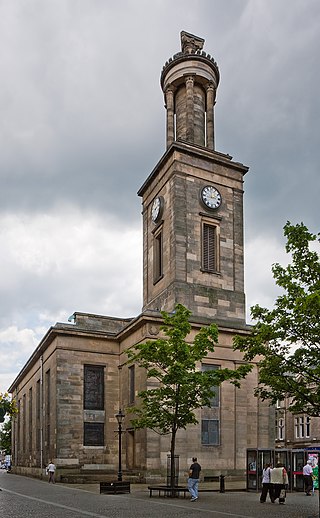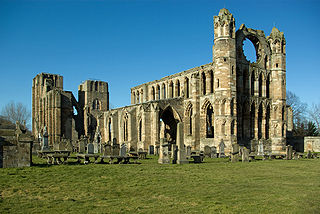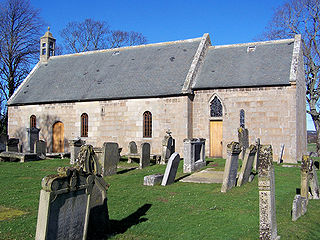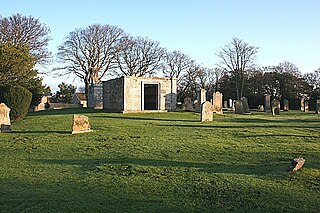
Elgin is a town and formerly a royal burgh in Moray, on the North Coast of Scotland. It is the administrative and commercial centre for Moray. The town originated to the south of the River Lossie on the higher ground above the floodplain where the town of Birnie is. There, the church of Birnie Kirk was built in 1140 and serves the community to this day.

Moray; or Morayshire, called Elginshire until 1919, is a historic county, registration county and lieutenancy area of Scotland, bordering Nairnshire to the west, Inverness-shire to the south, and Banffshire to the east. It was a local government county, with Elgin the county town, until 1975. The county was officially called Elginshire, sharing the name of the Elginshire parliamentary constituency, so named since 1708.

Alexander Stewart, Earl of Buchan, called the Wolf of Badenoch, was the third surviving son of King Robert II of Scotland by his first wife Elizabeth Mure. Alexander married the widowed Euphemia I, Countess of Ross, but they had no children. He did have a large family by his longtime mistress, Mairead inghean Eachainn.

Elgin Cathedral is a historic ruin in Elgin, Moray, north-east Scotland. The cathedral, dedicated to the Holy Trinity, was established in 1224 on land granted by King Alexander II outside the burgh of Elgin and close to the River Lossie. It replaced the cathedral at Spynie, 3 kilometres (2 mi) to the north, which was served by a small chapter of eight clerics. By 1226, the new and developing cathedral was staffed with 18 canons increasing to 23 by 1242. A damaging fire in 1270 resulted in a significantly enlarged building. It remained unaffected by the Wars of Scottish Independence, but again suffered extensive fire damage in 1390 when attacked by Robert III's brother Alexander Stewart, Earl of Buchan, also known as the Wolf of Badenoch. In 1402 the cathedral precinct again suffered an incendiary attack by the followers of the Lord of the Isles.
The Bishop of Moray or Bishop of Elgin was the ecclesiastical head of the Diocese of Moray in northern Scotland, one of Scotland's 13 medieval bishoprics. If the foundation charter of the monastery at Scone is reliable, then the Bishopric of Moray was in existence as early as the reign of King Alexander I of Scotland (1107–1124), but was certainly in existence by 1127, when one Gregoir ("Gregorius") is mentioned as "Bishop of Moray" in a charter of king David I of Scotland. The bishopric had its seat at Elgin and Elgin Cathedral, but was severally at Birnie, Kinneddar and as late as Bishop Andreas de Moravia at Spynie, where the bishops continued to maintain a palace. The Bishopric's links with Rome ceased to exist after the Scottish Reformation, but continued, saving temporary abolition between 1638 and 1661, under the episcopal Church of Scotland until the Revolution of 1688. Episcopacy in the established church in Scotland was permanently abolished in 1689. The Bishops fortified seat for over 500 years was at Spynie Palace.

Spynie Palace, also known as Spynie Castle, was the fortified seat of the Bishops of Moray for about 500 years in Spynie, Moray, Scotland. The founding of the palace dates back to the late 12th century. It is situated about 500 m from the location of the first officially settled Cathedral Church of the Diocese of Moray, Holy Trinity Church in present-day Spynie Churchyard. For most of its occupied history, the castle was not described as a palace — this term first appeared in the Registry of Moray in a writ of 1524.

Bricius was prior of Lesmahagow and afterward bishop of Moray.

Andreas de Moravia was a 13th-century Scottish bishop. He was a younger son of Hugh de Moravia, from the family of Flemish origin who were lords of Duffus and other areas in the Greater Moray region in this period. In the time of Bishop Bricius' episcopate (1203–1222), there was a man called "Andreas" who was rector of the church of St. Peter at Duffus, and this may well have been this Andreas. He may also have been a native Scot.
William de Bondington was a 13th-century Chancellor of Scotland and a bishop of Glasgow.

Fetternear Bishop's Palace is an archaeological site of what was one of the palaces of the medieval bishops of Aberdeen. It is near Kemnay in Aberdeenshire. Later, a ruined tower-house and mansion of Fetternear House were built on part of the site.

Spynie was a seaport, burgh and ancient parish in Moray, Scotland, that survives as a small hamlet and civil parish. It is the location of the ruins of Spynie Palace, which was the principal residence of the Bishops of Moray between the 12th and 17th centuries, and the churchyard of Holy Trinity Church, Spynie, which served as the cathedral of the Diocese of Moray between 1207 and 1224.

Henry de Lichton [de Lychtone, Leighton] was a medieval Scottish prelate and diplomat, who, serving as Bishop of Moray (1414–1422) and Bishop of Aberdeen (1422–1440), became a significant patron of the church, a cathedral builder, and a writer. He also served King James I of Scotland as a diplomat in England, France, and Italy.
William de Spynie was a Scottish prelate. He was a canon of Moray by 1363 and Precentor (Chanter) of Aberdeen in 1371. By 1372 x 1373, he had exchanged the latter position with William Boyl for the Precentorship of Moray. He had become Dean of Aberdeen by 1388. It is possible he had become Dean of Dunkeld in 1397, though this may be a mistake in the source, "Aberdeen" rather than "Dunkeld" being meant. At any rate, in that year he was elected as the Bishop of Moray. He travelled to France and on September 1397 was consecrated as Bishop.

Alexander Bur was a 14th-century Scottish cleric. It is highly possible that Bur came from somewhere in or around Aberdeenshire, although that is not certain and is only based on the knowledge that Aberdeenshire is where other people bearing his surname come from in this period. He entered the service of King David II of Scotland sometime after 1343, perhaps as a member of David's exiled court at Château Gaillard. Although Alexander by this point in time already held prebends in both the bishopric of Aberdeen and the bishopric of Dunkeld, on that date King David petitioned Pope Clement VI for another canonry in the bishopric of Moray. Alexander had become a royal clerk and had obtained a Licentiate in Canon Law by 1350. By the latter date, upon the death of Adam Penny, Archdeacon of Moray, Alexander himself became Archdeacon.
Adam de Darlington [Derlingtun] was a 13th-century English churchman based in the Kingdom of Scotland. Adam's name occurred for the first time in a Moray document datable between 1255 and 1271, where he was named as the Precentor of Fortrose Cathedral. He seems to have been introduced into the diocese of Ross, along with others from the north-east of England, by Bishop Robert de Fyvie, who may have been descended from the area.
Alexander de Kylwos – written alternatively as Frylquhous, Kylquos, and a variety of other forms – was a Scottish churchman and prelate active in the second half of the 14th century. He is known to have held senior positions in three bishoprics, and senior offices in two, before being elected and appointed Bishop of Ross in 1371. Though his episcopate is relatively obscure, he seems to have spent almost all of it inside or around his province, was closely associated with William III and Euphemia I, successive rulers of Ross, and was an associate of the famous Alexander Bur, Bishop of Moray, during the latter's struggle with Alexander Stewart, the son of the King later known by the nickname "Wolf of Badenoch".

Birnie Kirk is a 12th century parish church located near Elgin, in Moray, Scotland. It was the first cathedral of the Bishop of Moray and is one of the oldest in Scotland to have been in continuous use. The graveyard, symbol stone and archaeological remains under the church have been designated a scheduled monument by Historic Environment Scotland.

Kinneddar is a small settlement on the outskirts of Lossiemouth in Moray, Scotland, near the main entrance to RAF Lossiemouth. Long predating the modern town of Lossiemouth, Kinneddar was a major monastic centre for the Pictish kingdom of Fortriu from the 6th or 7th centuries, and the source of the important collection of Pictish stones called the Drainie Carved Stones. The Kirk of Kinneddar was the cathedral of the Diocese of Moray between 1187 and 1208, and remained an important centre of diocesan administration and residence of the Bishop of Moray through the 13th and 14th centuries.

Fortrose Cathedral was the episcopal seat (cathedra) of the medieval Scottish diocese of Ross in the Highland region of Scotland. It is probable that the original site of the diocese was at Rosemarkie, but by the 13th century the canons had relocated a short distance to the south-west, to the site known as Fortrose or Chanonry. According to Gervase of Canterbury, in the early 13th century the cathedral of Ross was manned by Céli Dé (culdees).

Holy Trinity Church, Spynie was until 1735 the parish church of Spynie, Moray in north-east Scotland, and served as the cathedral of the Diocese of Moray between 1207 and 1224.















